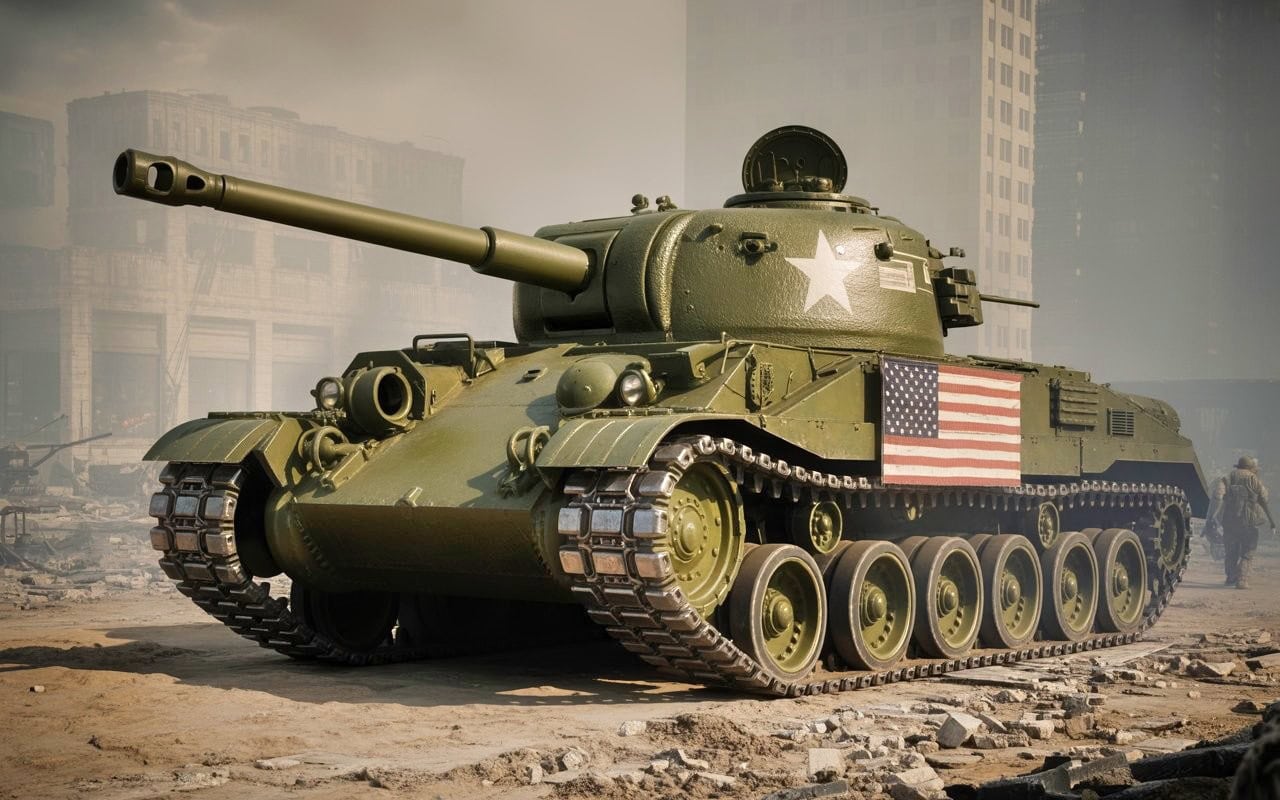The M26 Pershing is often overshadowed by the M4 Sherman’s long and glamorous World War II legacy.
Introduced in the latter years of that war, the Pershing did not see much combat and was soon replaced by the M48 Patton.
However, for its time, the M26 boasted a number of useful features.
Designing the M26 Pershing
Development of the M26 Pershing began in 1942, driven by the need for a more powerful tank that was better-protected than the M4 Sherman.
The project initially started with the T20 series of prototypes, which experimented with various design features, including new types of guns, suspensions, and transmissions.
The T20 series evolved into the T25 and T26 prototypes, which incorporated a 90-mm gun and much heavier armor.
The prototypes were in pursuit of a tank that could compete with the latest German armor, such as the King Tiger and Panther series.
One of the biggest changes of the M26 Pershing’s design was its torsion bar suspension, which improved mobility and stability compared to the Sherman’s vertical volute spring suspension.
The Pershing also featured a Ford GAF V-8 engine delivering 450-500 horsepower, which allowed the tank to reach 30 mph on roads.
Because of the engine’s design, the tank was able to assume a lower profile than the Sherman despite its heavier armor and armament. The tank’s armor was robust, with the upper hull boasting 102 mm of protection, while the turret sides had 76 mm.
Combat Performance
The M26 Pershing made its combat debut in the final months of World War II, during the invasion of Germany. Although limited Pershings saw action in Europe, their performance stood out. The Pershing’s 90-mm gun punished German tanks, including the Tiger I and Panther.
The tank’s armor better protected crews, and its mobility allowed it to maneuver effectively in various combat scenarios.
One of the most famous engagements involving the M26 Pershing occurred in Cologne, Germany, in March 1945. A Pershing tank commanded by Sergeant Robert Early destroyed a German Panther tank in a dramatic duel captured on film.
This encounter highlighted the Pershing’s capabilities and demonstrated the power of American tanks over the supposedly invincible German big cats.
Korea and Later Retirement
After World War II, the M26 performed in the Korean War. During this conflict, the Pershing proved superior to the tanks used by Communist forces, such as the Soviet T-34.
However, the rugged terrain of Korea exposed some of the Pershing’s limitations, including issues with its engine and transmission systems.
The Pershing was withdrawn from service soon after Korea. The tank did, however, serve as the foundation for subsequent American tank designs, leading to the development of the M46 Patton, which featured a more powerful engine and improved suspension.
The lineage continued with the M47, M48, and M60 Patton tanks, all of which incorporated lessons learned from the Pershing’s design and combat experience.
Departing From the Sherman
The Pershing was a significant departure from previous American tank designs. Its smaller engine gave it a lower profile than the M4 Sherman, making it harder to spot and hit. Its combination of firepower, mobility, and protection set new standards for armored vehicles.
Historians and tank experts often rank the Pershing behind the German Tiger II but ahead of the Tiger I and Panther in terms of overall effectiveness. Such an assessment underscores the Pershing’s impact on tank design and its role in shaping future armored-warfare strategies.
As the war went on, the Germans and the Soviets competed to see who could design the tank with the thickest armor and the largest gun. The Americans needed a tank that could go toe-to-toe with the German big cats, as well as the Soviet IS series tanks, after the war ended.
The Pershing’s 90-mm gun marked a shift towards more powerful armaments in American tanks. The torsion-bar suspension system first implemented in the Pershing also became a standard feature in later American tanks.
The M26 Pershing lived a short service life, serving only from 1944 to 1951. Yet it was a pivotal figure in American tank-design philosophy. Many of the design features of the Pershing were later carried over to the M48 Patton and later M60.

US M60 tank. Image Credit: Creative Commons.
Even the M1 Abrams shares a torsion-bar suspension system inherited in part from the Pershing. Its battlefield impact may have been small, but its design influence is still felt.
About the Author
Isaac Seitz, a 19FortyFive Defense Columnist, graduated from Patrick Henry College’s Strategic Intelligence and National Security program. He has also studied Russian at Middlebury Language Schools and has worked as an intelligence Analyst in the private sector.

